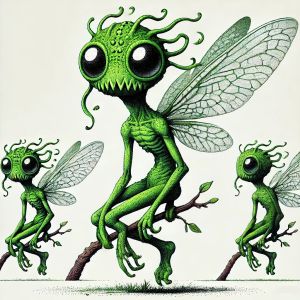Branmik
From Harthorns-Reverie
The Branmik is a small, fairy-like creature that was once the most common pet among the Myah-Zeitzho on their homeworld. These delicate beings were brought to Earth as part of the Myah-Zeitzho's agreement with the U.N., and like their owners, their numbers have dwindled significantly. Despite their mysterious origins and the challenges of adapting to a new environment, the surviving Branmiks are cherished as family pets by the few remaining Myah-Zeitzho families.

Physical Characteristics
- Humanoid Figures: Branmiks have a small, humanoid appearance, standing at an average height of 9-12 inches. Their bodies are slender and lightweight, with an average weight of 6-9 pounds. They have an almost ethereal quality, with their thin, green, stem-like skin giving them a plant-like appearance.
- Wings: Branmiks possess eight delicate, translucent wings that resemble those of a dragonfly or fairy. These wings are long and capable of wrapping around their bodies, which they often do when sleeping, creating a protective cocoon-like "sleeping bag." The wings are strong enough to allow them to hover and dart through the air with agility, though they primarily use them for short bursts of flight.
- Eyes and Facial Features: Branmiks have large, bulging white eyes that are highly expressive, allowing them to communicate emotions and intentions. They lack the ability to speak but compensate with their facial expressions and a series of high-pitched sounds, including grunts, chimes, and chirps. Their chirping is similar to the sound made by crickets and is produced through a similar process, using specialized organs in their mouths.
- Mouth and Feeding: The Branmik's mouth is zigzag-shaped, and instead of a tongue, they have a unique organ that acts as a sucker. This organ is used to feed on algae, their primary food source. They lack traditional sexual organs and reproduce by budding seeds, which are then distributed into a batch of algae. The seeds emit a specific scent that signals other Branmiks to avoid that area, ensuring that the growing offspring are left undisturbed.
- Limbs: Branmiks have three fingers on their wrist-less hands, which are highly dexterous despite their small size. Their feet come to a point, lacking toes, which further adds to their otherworldly appearance. These pointed feet are well-suited for perching on branches, ledges, or even the shoulders of their Myah-Zeitzho owners.
Behavior and Communication
- Non-Verbal Communication: Unable to speak, Branmiks communicate through a combination of facial expressions and high-pitched sounds. Their expressive eyes and facial muscles convey a wide range of emotions, from contentment to fear. Their chirping is used to signal different states, such as hunger, happiness, or alertness, making them quite communicative despite their lack of verbal language.
- Social Behavior: Branmiks are social creatures and often form strong bonds with their Myah-Zeitzho owners. They are affectionate and enjoy being close to their family members, often perching on their shoulders or hovering nearby. Despite their small size, they exhibit a strong sense of loyalty and will attempt to protect their owners if they sense danger.
- Feeding and Reproduction: Branmiks feed primarily on algae, which they extract using their specialized mouth organ. Their diet is simple, but they require a lot of food during their early growth stages. Once they reach maturity, they can survive up to four days without nutrients. Reproduction occurs through budding, with the seeds being distributed into algae patches, which serve as both food and a protective environment for the developing offspring.
Cultural Significance
- Cherished Companions: On their homeworld, Branmiks were beloved pets, known for their gentle nature and the sense of calm they brought to their owners. They were often seen as symbols of peace and tranquility, and their presence in a home was considered a blessing.
- Adaptation to Earth: After being brought to Earth, Branmiks struggled to adapt to the new environment, and many did not survive. However, the ones that did are now considered rare and valuable. They are a living link to the Myah-Zeitzho's lost homeworld, and their survival is seen as a symbol of resilience and hope.
- Connection to the Myah-Zeitzho: The bond between the Myah-Zeitzho and their Branmik pets is deep, with the creatures often viewed as extensions of the family. The Myah-Zeitzho take great care in preserving the few Branmiks that remain, seeing them as a vital part of their cultural heritage.
Challenges and Conservation
- Endangered Status: With the destruction of their homeworld and the challenges of adapting to Earth's environment, Branmiks are now an endangered species. Conservation efforts are focused on preserving the remaining population, with some Myah-Zeitzho families dedicating themselves to breeding and caring for these delicate creatures.
- Mysterious Origins: Much about the Branmiks' origins remains unknown, including their evolutionary history and the full extent of their abilities. Research into their biology is ongoing, with the hope of uncovering more about their past and ensuring their future survival.
Trivia
- Nighttime Chirping: Branmiks are known for their soothing nighttime chirping, which many Myah-Zeitzho find comforting. The sound is said to resemble a lullaby, helping both Branmiks and their owners sleep peacefully.
- Algae Cultivation: Myah-Zeitzho families often cultivate specific types of algae to feed their Branmiks, creating a small, self-sustaining ecosystem within their homes. This practice has become a cultural tradition, passed down through generations.